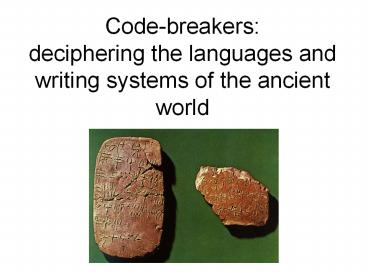Code-breakers: deciphering the languages and writing systems of the ancient world - PowerPoint PPT Presentation
1 / 28
Title:
Code-breakers: deciphering the languages and writing systems of the ancient world
Description:
Cuneiform (Wedge-shaped script): Sumerian, Akkadian, Old Persian, Babylonian, Elamite, Luwian. ... When the tenth dawn shone with her rose-red fingers, ... – PowerPoint PPT presentation
Number of Views:188
Avg rating:3.0/5.0
Title: Code-breakers: deciphering the languages and writing systems of the ancient world
1
Code-breakers deciphering the languages and
writing systems of the ancient world
2
Writing systems
- Hieroglyphs Egypt, Anatolia, Crete
- Cuneiform (Wedge-shaped script) Sumerian,
Akkadian, Old Persian, Babylonian, Elamite,
Luwian. - Linear A (Syllabograms?) Unknown language Minoans
not Greek - Linear B (Syllabograms for Greek) Mycenaeans were
Greek - Ogham (Irish system) Gaelic/Irish
3
HieroglyphicScripts
- Hieros
- - sacred
- Glyphein
- - to carve
- Egyptian
- Anatolian or
- Hittite or
- Luwian
- Cretan
- Mayan
4
Egyptian Hieroglyphs
- 3,300 bc
- Logograms (word)
- Ideograms (idea)
- Alphabetic letters
5
The Rosetta Stone
- Napoleon in Egypt
- 1798-1801
- Jean-François Champollion
- 1822 Translation
- 3 scripts
- Greek
- Hieroglyphic Egyptian
- Demotic Egyptian
- (easier to write on papyri)
6
Luwian Language
- Hittites
- Hieroglyphs Cuneiform
- Trojans? Seal with Luwian Hieroglyphics
7
From Pictogram to Cuneiform
8
Cuneiform Technique
9
Cuneiform Texts
10
Deciphering Cuneiform
11
The Behistun Inscription
- Old Persian, Elamite, Babylonian
- Darius I (521-486 bc)
- Henry Rawlinson, Edward Hincks
12
Interlude
- Stop it, you little monster, or Ill go out to
the barn, and tell your father! - Pasiphae and Minotaur
- RF vase, Etruria, c.340bc
13
Cretan Hieroglyphics The Phaistos Disk
- Related scripts, partly syllabic, partly
logographic - Linear A
- Anatolian hieroglyphs
- Egyptian hieroglyphs.
14
The Minoans Linear A
- Arthur Evans
- Unknown language (NOT Greek)
- Minoan, Eteocretan?
- Linear B syllabograms derived from Linear A
- Linear A Luwian?
- Linear A Phoenician?
- John Younger
15
The Mycenaeans Linear B
- Arthur Evans effect
- Linear B Etruscan?
- Syllabograms Logograms
- Total of 200 signs
16
Michael Ventris
- Michael Ventris
- 1922-1956
- John Chadwick
- Inflected Language Declensions
- Conjugations
- Cretan Place names?
- Greek!
17
Greek in Syllabograms
18
Linear B Mycenaean Social Order
- WA-NA-KA wanax The King
- RA-WA-KE-TA lawagetas
- Leader of the People Prince?
- E-QE-TA heqetas
- Companion or Member of Warrior Caste?
- KE-RO-SI-JA geronsia Council of Elders?
- DA-MO damos village
- KO-RE-TE, PO-RO-KO-RE-TE koreter, prokoreter
Official Deputy - DO-E-RO, DO-E-RA doeros, doera
- Slave/Servant (doulosslave)
19
Phoenician Alphabet
- Semitic letter names
- Aleph - ox - alpha
- Bet - house - beta
20
Greek Alphabet
21
Alphabet in History
- Herodotus
- The Phoenicians who came with Cadmus introduced
into Greece a number of accomplishments, of
which the most important was writing, an art till
then, I think, unknown to the Greeks.
22
Or Is it Pure Myth?
- Cadmus, brother of Europa
- Founder of Thebes
- Date?
23
Family Tree of Danaos Cadmus
- POSEIDON_____________LIBYA
- I
- __________I__________
- I I AGENOR
BELUS - I __________I______
- CADMUS I I
- AEGYPTUS DANAOS
- I I
- I I
- 50 SONS 50 DAUGHTERS
24
Cadmus Myth
- Cadmus, founder of Thebes, preceded Trojan War
by several generations - Conventional date of Trojan War
- early C12th bc
- Cadmus C14th bc
- Cadmeian alphabet not found in Greece before
about the middle of C8th bc.
25
Writing in Homer Iliad 6.197-202
- He (Proetus, King of Argos) balked at killing the
man (Bellerophon) - hed some respect at least. - But he quickly sent him off to Lycia, gave him
tokens, - Murderous signs, scratched in a folded tablet,
- And many of them, too, enough to kill a man.
- He told him to show them to the father of Antea
(wife of Proetus, false accuser of B) - That would mean his death
26
Baleful Signs
- When the tenth dawn shone with her rose-red
fingers, - He began to question him, asked to see his
credentials, - But then, once he received that fatal message
- Sent from his own daughters husband, first
- He ordered Bellerophon to kill the Chimaera
27
Memory of Linear B or New Phoenician Alphabet?
- Uluburun shipwreck writing tablets
- late C14th bc
- Cypriot or Levantine Origin?
- LHIIIA2 pottery
- Cargo from entire Aegean world Mycenaean,
Cypriot, Canaanite, Kassite, Egyptian, and
Assyrian.
28
Oghamcarved read from bottom to top
- 5th century Ireland (Wales, Cornwall, Scotland,
Isle of Man, Shetland Islands). - letters consist of 1-5 perpendicular or angled
strokes, meeting or crossing a center line. - letters easily carved on wood or stone objects,
with edge of object forming the center line. - Irish had no other written alphabet until
Christian missionaries introduced Latin (C8th) - Ogham died after first few centuries of Christian
era, as use of inscription languages was reviled
as a pagan practice.































